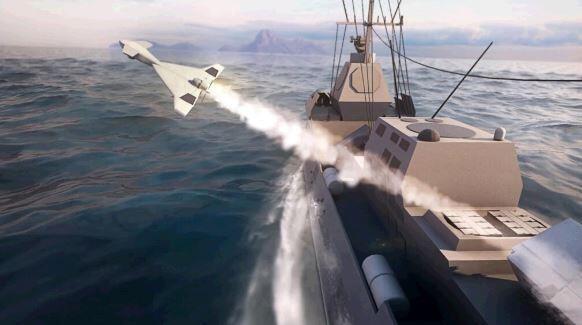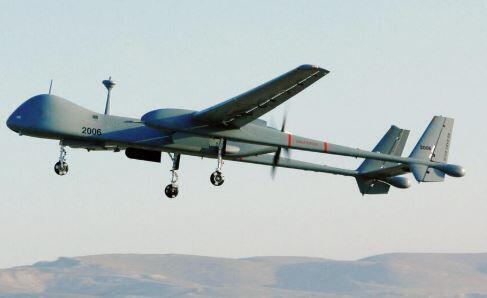The ongoing conflict between the Indian and Pakistani armies has recently shifted global attention away from Israel's multi-front conflict plaguing the Middle East for over a year and a half. This escalation has sparked growing fears of a potential full-scale war between the nuclear-armed rivals. On Saturday, President Trump announced on that he had successfully brokered agreements for a ceasefire between the two nations. However, despite these efforts, clashes continued over the weekend.
Among the weaponry prominently featured in the Indian arsenal during these skirmishes were Israeli-made systems, delivered to India through a series of deals spanning the last two decades. One of the most notable of these is the Harop, a suicide drone.
The Harop, in the class of loitering munitions, is designed to hover over a target area for extended periods before striking. It has an operational range of several hundred kilometers and carries an explosive payload weighing around 22 lbs. The drone can loiter for approximately six hours, flying at high altitudes miles above its target. Its operator, situated far from the battlefield, can command the Harop to dive toward its target, where it detonates on impact, ensuring the destruction of the intended objective. Developed and manufactured by Israel Aerospace Industries (IAI) at its central Israel facility, the Harop is part of a broader family of loitering munitions drones, including the Harpy and the Mini-Harpy. Each unit costs hundreds of thousands of dollars.
India began acquiring the Harop nearly 15 years ago, and its use has expanded significantly in recent years through deals estimated to be worth hundreds of millions of dollars. Last week, during a series of Indian strikes on the Pakistani-controlled side of the Kashmir region, dozens of these loitering munitions were employed. According to reports from Pakistan, its military intercepted between 12 and 25 of these drones during the clashes.
Social media circulated images of the remains of intercepted drones, although it remains unclear whether these were stopped before they reached their targets or if they were remnants of drones that had already completed their missions. One of the fragments reportedly bore markings from Enercon Technologies, a company based in the Barkan Industrial Zone near Ariel, which specializes in producing power systems for the defense industry. Enercon Technologies was recently acquired by the American firm Bel Fuse, an electronic connector manufacturing company, for $320 million.
Pakistan also claimed to have downed a Heron drone, another IAI product previously sold to the Indian Air Force. Meanwhile, India countered these claims, stating it had intercepted several dozen UAVs launched by the Pakistani military.
The Kashmir region, long a hotspot for conflict, is not the first arena where Israeli loitering munitions have been deployed. Azerbaijan’s military had previously purchased the Harop and used it against Armenian forces during the ongoing clashes in the Nagorno-Karabakh region.
In addition to IAI, Elbit Systems-another major Israeli defense contractor-has also supplied military technology to India in recent years. Among these is the SkyStriker, another type of loitering munition. While similar in function to the Harop, the SkyStriker has a shorter operational range, with a flight time of about two hours and a smaller warhead weighing approximately 11 lbs. It is designed for covert operations, capable of flying at high speeds while maintaining a low acoustic signature. Like many militaries worldwide, the Indian Army is also equipped with thousands of Spike anti-tank missiles manufactured by Rafael.
India’s efforts to strengthen its military, primarily to counter threats from China and Pakistan, led to the acquisition of SkyStrikers four years ago in a deal valued at approximately $100 million. A key condition of this agreement required that the SkyStriker be produced locally in India, with Elbit transferring the necessary technological expertise for local manufacturing.
Elbit also collaborates with Indian companies to produce its main UAVs, the Hermes 450 and Hermes 900, for the Indian military. Beyond unmanned aerial vehicles and loitering munitions, India has also procured Barak 8 defense missiles, jointly developed by IAI and the Indian Ministry of Defense. These missiles are integrated into Indian Navy warships and have been adapted for use by the Air Force and Army under a $3 billion industrial cooperation agreement.
The conflict between India and Pakistan has also unveiled glimpses of Chinese weaponry deployed by the Pakistani military. Among the most notable is the J-10 fighter jet, manufactured by the Chengdu Aircraft Industry Group in China’s Sichuan Province. Pakistan has acquired at least one squadron of J-10s, intended as a countermeasure to India’s purchase of Dassault Rafale fighter jets from France. Aviation experts have remarked on the similarities between the J-10 and Israel’s Lavi fighter jet. The Lavi, developed by IAI, was ultimately canceled in 1987 due to economic constraints and heavy pressure from the United States.
Experts speculate that some of the technologies originally developed for the Lavi, such as communication systems, avionics, radar and composite materials, might have made their way to China after the project was discontinued. However, these claims have never been officially confirmed by Israeli authorities. Reports indicate that a J-10 fighter jet operated by the Pakistani Air Force shot down two Indian aircraft during an aerial battle.
The United States and other Western nations are closely monitoring developments to analyze the performance of the J-10 and other Chinese weapon systems, including long-range air-to-air missiles and air defense systems. This analysis aims to extract insights in anticipation of potential future confrontations involving Chinese weaponry.
Two weeks ago, India’s Ministry of Defense approved the purchase of additional Dassault Rafale, a French twin-engine, canard delta wing, multirole fighter jet, from France in a deal worth nearly $7.5 billion. These jets are expected to be delivered by the end of the decade. The ongoing escalation in Kashmir may push India to make decisions regarding further aircraft acquisitions. Reports suggest that India is weighing the purchase of Russia’s advanced Su-57 fighter jets against the American F-35s manufactured by Lockheed Martin.
U.S. President Donald Trump has urged Indian Prime Minister Narendra Modi to opt for the American F-35 as part of efforts to strengthen strategic ties between the two nations. However, India’s deliberation between Russian and American jets is widely seen as a negotiating tactic to secure a lower price from the United States.
Get the Ynetnews app on your smartphone: Google Play: https://bit.ly/4eJ37pE | Apple App Store: https://bit.ly/3ZL7iNv
What could ultimately sway India toward the F-35 is the extensive operational experience it has gained, particularly during its use by the Israeli Air Force in the ongoing Gaza conflict. This shift aligns with India’s broader trend of reducing its dependence on Russian arms. Once a primary supplier, Russia’s ongoing war in Ukraine has cast doubt on its ability to fulfill arms contracts as it prioritizes its domestic military needs.
Meanwhile, India is leveraging the global surge in demand for weapons, driven by the Russia-Ukraine war, to position itself as a major arms exporter. It seeks to fill markets previously dominated by Russia, including South America, Africa and parts of the Arab world.
Israeli defense companies, though highly regarded and dominant in the Indian market, must continually adapt to remain competitive. Integrating into India’s vision of becoming a leading global arms supplier in the coming years requires ongoing technological cooperation and the transfer of knowledge to support local manufacturing. Foreign companies are required to form joint ventures with Indian firms, with local entities maintaining control—posing challenges for Israeli companies operating in an already competitive market.
In 2023, Israel set a record with over $13 billion in defense exports, with about half directed to Asian countries, including India. The primary exporters—Elbit Systems, IAI, and Rafael—continue to dominate Israeli arms sales worldwide. Despite international criticism and sanctions imposed due to the Gaza conflict, Israeli weapons remain highly sought after, underscoring the complex dynamics of the global arms trade.



